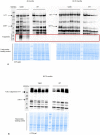Transgenic minipig model of Huntington's disease exhibiting gradually progressing neurodegeneration
- PMID: 31645369
- PMCID: PMC6918760
- DOI: 10.1242/dmm.041319
Transgenic minipig model of Huntington's disease exhibiting gradually progressing neurodegeneration
Abstract
Recently developed therapeutic approaches for the treatment of Huntington's disease (HD) require preclinical testing in large animal models. The minipig is a suitable experimental animal because of its large gyrencephalic brain, body weight of 70-100 kg, long lifespan, and anatomical, physiological and metabolic resemblance to humans. The Libechov transgenic minipig model for HD (TgHD) has proven useful for proof of concept of developing new therapies. However, to evaluate the efficacy of different therapies on disease progression, a broader phenotypic characterization of the TgHD minipig is needed. In this study, we analyzed the brain tissues of TgHD minipigs at the age of 48 and 60-70 months, and compared them to wild-type animals. We were able to demonstrate not only an accumulation of different forms of mutant huntingtin (mHTT) in TgHD brain, but also pathological changes associated with cellular damage caused by mHTT. At 48 months, we detected pathological changes that included the demyelination of brain white matter, loss of function of striatal neurons in the putamen and activation of microglia. At 60-70 months, we found a clear marker of neurodegeneration: significant cell loss detected in the caudate nucleus, putamen and cortex. This was accompanied by clusters of structures accumulating in the neurites of some neurons, a sign of their degeneration that is also seen in Alzheimer's disease, and a significant activation of astrocytes. In summary, our data demonstrate age-dependent neuropathology with later onset of neurodegeneration in TgHD minipigs.
Keywords: Brain; Huntingtin; Large animal model; Neuropathology; TgHD.
© 2019. Published by The Company of Biologists Ltd.
Conflict of interest statement
Competing interestsThe authors declare no competing or financial interests.
Figures








References
-
- Askeland G., Rodinova M., Štufková H., Dosoudilova Z., Baxa M., Smatlikova P., Bohuslavova B., Klempir J., Nguyen T. D., Kuśnierczyk A. et al. (2018). A transgenic minipig model of Huntington's disease shows early signs of behavioral and molecular pathologies. Dis. Model. Mech. 11, dmm035949 10.1242/dmm.035949 - DOI - PMC - PubMed
-
- Bartzokis G., Lu P. H., Tishler T. A., Fong S. M., Oluwadara B., Finn J. P., Huang D., Bordelon Y., Mintz J. and Perlman S. (2007). Myelin breakdown and iron changes in Huntington's disease: pathogenesis and treatment implications. Neurochem. Res. 32, 1655-1664. 10.1007/s11064-007-9352-7 - DOI - PubMed
Publication types
MeSH terms
Substances
LinkOut - more resources
Full Text Sources
Medical

